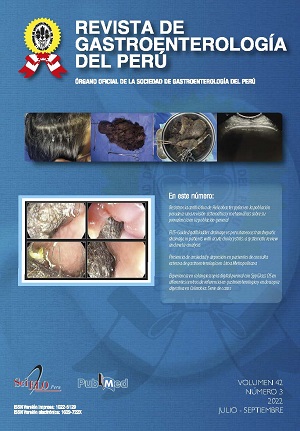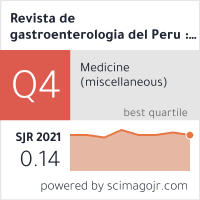EUS-Guided gallbladder drainage vs percutaneous transhepatic drainage in patients with acute cholecystitis: a systematic review and meta-analysis
DOI:
https://doi.org/10.47892/rgp.2022.423.1375Keywords:
Endosonography, Gallbladder, drainage, percutaneous transhepatic drainage, Cholecystitis, AcuteAbstract
Occasionally, cholecystectomy is not possible because the patient is not suitable for surgery, and non-operative management should be performed. In these patients, the non-operative management can be through the percutaneous transhepatic gallbladder drainage (PTGBD) or the endoscopic gallbladder drainage. We decided to compare the efficacy and safety of PTGBD and EUS-GBD in the non-operative management of patients with acute cholecystitis. We conducted a systematic review in different databases, such as PubMed, OVID, Medline, and Cochrane Databases. This meta-analysis considers studies published until September 2021. Six studies were selected (2 RCTs). These studies included 749 patients. The mean age was 72.81 ±7.41 years, and males represented 57.4%. EUS-GBD technical success was lower than PTGBD (RR, 0.97; 95% CI, 0.95-0.99), whereas clinical success and adverse events rates were similar in both groups. Twenty-one deaths were reported in all six studies. The global mortality rate was 2.80%, without differences in both groups (2.84% and 2.77% in the EUS-GBD group and the PTGBD groups, respectively). EUS-GBD and PTGBD were successful techniques for gallbladder drainage in patients with acute cholecystitis who are non-tributary for surgery. EUS-GBD has a similar clinical success rate and a similar adverse events rate in comparison to PTGBD. The high technical success and the low adverse events rate of the EUS approach to gallbladder make this technique an excellent alternative for patients with acute cholecystitis who cannot be undergoing surgery.
Downloads
Metrics
References
Pisano M, Allievi N, Gurusamy K, et al. 2020 World Society of Emergency Surgery updated guidelines for the diagnosis and treatment of acute calculus cholecystitis. World J Emerg Surg 2020;15:61
Schmidt M, Sondenaa K, Vetrhus M, Berhane T, Eideet G, et al. Long-term follow-up of a randomized controlled trial of observation versus surgery for acute cholecystitis: non-operative management is an option in some patients. Scand J Gastroenterol. 2011;46:1257–62
Khan M, Atiq O, Kubiliun N, et al. Efficacy and safety of endoscopic gallbladder drainage in acute cholecystitis: Is it better than percutaneous gallbladder drainage? Gastrointest Endosc. 2017;85:76–87.
Ahmed O, Ogura T, Eldahrouty A, et al. Endoscopic ultrasound-guided drainage I acute cholecystitis: results of a long-term follow-up. Saudi J Gastroenterol. 2018;24:183–8.
Law R, Grimm I, Stavas J, Baron T, et al. Conversion of percutaneous cholecystostomy to internal transmural gallbladder drainage using an endoscopic ultrasound-guided, lumen-apposing metal stent. Clin Hepatol Gastroenterol. 2016;14: 476–80.
Chantarojanasiri T, Matsubara S, Isayama H, et al. Feasibility of conversion of percutaneous cholecystestomy to internal transmural endoscopic ultrasound-guided gallbladder drainage. Saudi J Gastroenterol. 2017;23:318–22.
Easterbrook P, Berlin J, Gopalan R, Matthews D. Publication bias in clinical research. Lancet 1991;337:867-72
Duval S, Tweedie R. Trim and fill: A simple funnel-plot-based method of testing and adjusting for publication bias in meta-analysis. Biometrics 2000;56:455-63
Vetrhus M, Berhane T, Soreide O, Søndenaaet K. Pain persists in many patients five years after removal of the gallbladder: observations from two randomized controlled trials of symptomatic, noncomplicated gallstone disease and acute cholecystitis. J Gastrointest Surg 2005;9:826–31.
Trowbridge R, Rutkowski N, Shojania K. Does this patient have acute cholecystitis? JAMA 2003;289:80–6.
Macafee D, Humes D, Bouliotis G, Beckingham J, Whynes D, Loboet D. Prospective randomized trial using cost-utility analysis of early versus delayed laparoscopic cholecystectomy for acute gallbladder disease. Br J Surg 2009;96:1031–40.
Gingrich R, Awe W, Boyden A, Petersonet C. Cholecystostomy in acute cholecystitis. Factors influencing morbidity and mortality. Am J Surg 1968;116:310–5.
Glenn F. Cholecystostomy in the high risk patient with biliary tract disease. Ann Surg 1977;185:185–91.
Roslyn J, Binns G, Hughes E, Saunders-Kirkwood K, Zinner M, Cateset J. Open cholecystectomy. A contemporary analysis of 42,474 patients. Ann Surg 1993;218: 129–137.
Kiviniemi H, Makela J, Autio R, et al. Percutaneous cholecystostomy in acute cholecystitis in high-risk patients: an analysis of 69 patients. Int Surg 1999;83:299–302.
Davis C, Landercasper J, Gundersen L, Lambert P. Effective use of percutaneous cholecystostomy in high-risk surgical patients: techniques, tube management, and results. Arch Surg 1999;134: 727–31.
England R, McDermott V, Smith T, Suhocki P, Payne C, Newmanet G. Percutaneous cholecystostomy: who responds? AJR Am J Roentgenol 1997;168: 1247–51.
McGahan J, Lindfors K. Percutaneous cholecystostomy: an alternative to surgical cholecystostomy for acute cholecystitis? Radiology 1989;173:481–5.
Chopra S, Dodd G 3rd, Mumbower A, et al. treatment of acute cholecystitis in non-critically ill patients at high surgical risk: comparison of clinical outcomes after gallbladder aspiration and after percutaneous cholecystostomy. AJR Am J Roentgenol 2001;176:1025-31.
Winbladh A, Gullstrand P, Svanvik J, Sandström P. Systematic review of cholecystostomy as a treatment option in acute cholecystitis. HPB (Oxford) 2009;11:183-93.
Sanjay P, Mittapalli D, Marioud A, White R, Ram R, Alijaniet A. Clinical outcomes of a percutaneous cholecystostomy for acute cholecystitis: a multicentre analysis. HPB (Oxford) 2013;15:511-6.
Widmer J, Singhal S, Gaidhane M, Kahalehet M. Endoscopic ultrasound-guided endoluminal drainage of the gallbladder. Dig Endosc 2014;26:525-31.
Kedia P, Sharaiha R, Kumta N, et al. Endoscopic gallbladder drainage compared with percutaneous drainage. Gastrointest Endosc. 2015;82:1031-6.
Downloads
Published
How to Cite
Issue
Section
License
Revista de Gastroenterología del Perú by Sociedad Peruana de Gastroenterología del Perú is licensed under a Licencia Creative Commons Atribución 4.0 Internacional..
Aquellos autores/as que tengan publicaciones con esta revista, aceptan los términos siguientes:
- Los autores/as conservarán sus derechos de autor y garantizarán a la revista el derecho de primera publicación de su obra, el cuál estará simultáneamente sujeto a la Licencia de reconocimiento de Creative Commons que permite a terceros compartir la obra siempre que se indique su autor y su primera publicación esta revista.
- Los autores/as podrán adoptar otros acuerdos de licencia no exclusiva de distribución de la versión de la obra publicada (p. ej.: depositarla en un archivo telemático institucional o publicarla en un volumen monográfico) siempre que se indique la publicación inicial en esta revista.
- Se permite y recomienda a los autores/as difundir su obra a través de Internet (p. ej.: en archivos telemáticos institucionales o en su página web) antes y durante el proceso de envío, lo cual puede producir intercambios interesantes y aumentar las citas de la obra publicada. (Véase El efecto del acceso abierto).

















 2022
2022 